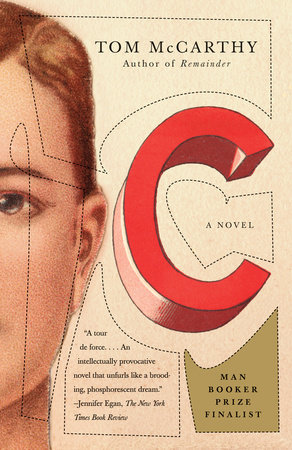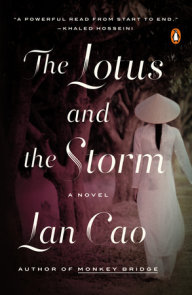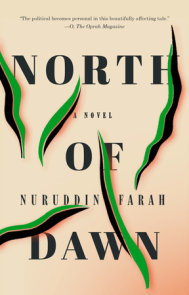READERS GUIDE
The questions, discussion topics, and reading list that follow are intended to enhance your reading group’s discussion of C, Tom McCarthy’s daring follow-up to Remainder, his stunning debut.Introduction
“A tour de force. . . . An intellectually provocative novel that unfurls like a brooding, phosphorescent dream.” —Jennifer Egan, The New York Times Book ReviewThe acclaimed author of Remainder, which Zadie Smith hailed as “one of the great English novels of the past ten years,” gives us his most spectacularly inventive novel yet.
Opening in England at the turn of the twentieth century, C is the story of a boy named Serge Carrefax, whose father spends his time experimenting with wireless communication while running a school for deaf children. Serge grows up amid the noise and silence with his brilliant but troubled older sister, Sophie: an intense sibling relationship that stays with him as he heads off into an equally troubled larger world.
After a fling with a nurse at a Bohemian spa, Serge serves in World War I as a radio operator for reconnaissance planes. When his plane is shot down, Serge is taken to a German prison camp, from which he escapes. Back in London, he’s recruited for a mission to Cairo on behalf of the shadowy Empire Wireless Chain. All of which eventually carries Serge to a fitful—and perhaps fateful—climax at the bottom of an Egyptian tomb . . .
Only a writer like Tom McCarthy could pull off a story with this effortless historical breadth, psychological insight, and postmodern originality.
Questions and Topics for Discussion
1. There are many C’s in C. On page 292, Pacorie says to Serge:
“Surtout, the C: the C is everywhere.”
“The sea?” asks Serge.
“The letter: C.”
“What’s C?”
“Carbon: basic element of life.”
What is the significance of carbon throughout the novel? What other C’s do you notice, and what might they mean?
2. Read the epigraph from Omar Khayyám. What does this tell us about what we’re about to read?
3. How does McCarthy use the metaphor of transmission and reception? How does the recurrence of codes in the novel tie in to this?
4. At one point in the novel, a character is buried with a wireless transmitter key. How does the relationship between technology and mourning play out in the novel?
5. Serge has trouble with physical perspective. How does this affect his behavior? How does he fare with psychological perspective?
6. How would you describe Serge’s relationship with Sophie? What aspects of their childhood relationship does Serge retain throughout his life? What parts—if any—is he able to leave behind?
7. Discuss the pageant at Versoie. Why did Mr. Carrefax choose the story of Persephone? How does it tie in to the novel’s themes?
8. “What he means is that he doesn’t think of what he’s doing as a deadening. Quite the opposite: it’s a quickening, a bringing to life” (page 159). How does Serge’s attitude toward life and death help him in the war and beyond? How does it harm him?
9. “Just Imagine,” Simeon Carrefax says to Serge on page 198, “if every exciting or painful event in history has discharged waves of similar detectability into the ether—why, we could pick up the Battle of Hastings, or observe the distress of the assassinated Caesar. . . These things could still be happening, right now, around us.” What does this tell the reader about Simeon? And what does Serge’s reaction reveal?
10. In London, Serge develops a heroin habit: “Every week Serge hands over to Barney the fruit of Versoie’s trees and beehives, Barney hands over the goods, and sister roils and courses through his veins” (page 185). What effects does Serge achieve through his drug use? What does he escape thereby, and what—if anything—do the drugs help him see more clearly?
11. Discuss the Miss Dobai setpiece. What point is McCarthy making here?
12. What role does Widsun play? When he requests a private appendix to Serge’s report, what is he asking for?
13. Reread the passage that begins in the middle of page 253, with “Ignoring his words. . .” How is Petrou’s explanation of Sophia significant?
14. Falkiner says to Serge, “This is part of what we’re studying, or should be studying: you have to look at all of this, at all these histories of looking” (page 278). What does he mean by, “histories of looking”? How does this affect your reading of the novel?
15. What is the significance of Osiris and Isis for Serge and Sophie? Why does Serge say, “Isis was a coherer” (page 284)?
16. Serge writes Méfie-toi, “beware,” in his notebook. Why?
17. On page 290, Laura tells Serge that in some burials, “the deceased’s unreported deeds, clandestine history and guilty conscience” were recorded on scarabs. What do insects represent in the novel, from Mrs. Carrefax’s silkworms to the one that bites Serge?
18. How would you interpret Serge’s hallucinations and fever dreams on his journey back to Cairo?
19. 19. Read the complete text of Shakespeare’s Sonnet 65. How does it relate to Serge’s life?
Since brass, nor stone, nor earth, nor boundless sea,
But sad mortality o’ersways their power,
How with this rage shall beauty hold a plea,
Whose action is no stronger than a flower?
O, how shall summer’s honey breath hold out
Against the wreckful siege of batt’ring days,
When rocks impregnable are not so stout,
Nor gates of steel so strong, but Time decays?
O, fearful meditation! where, alack,
Shall Time’s best jewel from Time’s chest lie hid?
Or what strong hand can hold his swift foot back?
Or who his spoil of beauty can forbid?
O, none, unless this miracle have might,
That in black ink my love may still shine bright.
20. What is a dummy chamber? Why does Serge, in his delirium, say they’re “everywhere” (page 309)?
21. Reread and discuss the last paragraph of the novel. How did you interpret it?
(For a complete list of available reading group guides, and to sign up for the Reading Group Center enewsletter, visit www.readinggroupcenter.com)




















